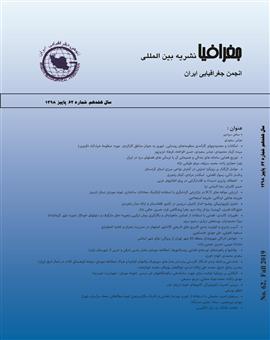تحلیل ژئوپولیتیکی چشم انداز آمایش سرزمین در کشور افغانستان و ارائه مدل راهبردی
محورهای موضوعی :عتیق الله قمری 1 , کیومرث یزدان پناه درو 2 , زهرا پیشگاهی فرد 3 , حسین حاتمی نژاد 4
1 - دانشگاه تهران
2 - هيات علمي دانشگاه تهران
3 - دانشگاه تهران
4 - دانشگاه تهران
کلید واژه: آمایش سرزمین, ژئوپولیتیک, مدل راهبردی, توسعه و امنیت پایدار, افغانستان.,
چکیده مقاله :
در ساختار اقتصاد سیاسی جهان برخی کشورها توسعه یافته و برخی در حال توسعه می باشند. برخی از کشورها نیز به دلیل شکنندگی ژئوپولیتیکی و تهدیدات و بحران های داخلی و محیط خارجی نه تنها توسعه نیافته اند بلکه در مسیر توسعه نیز در حال حرکت نیستند. افغانستان نیز در حال حاضر جزء کشورهای بحرانی و توسعه نیافته جهان محسوب می گردد که هیچ چشم انداز مشخصی برای حرکت در جهت توسعه ندارد؛ نه در سطح نظریه پایه توسعه، نه راهبردهای مشخص و منسجم توسعه و نه هیچگونه سند عملیاتی با ضمانت اجرا. این مشکلات افغانستان ریشه در مسائل جغرافیایی، فرهنگی، سیاسی و امنیتی داخلی و خارجیدارد. بنابراین برنامه ریزی جهت توسعه سرزمینی این کشور نیز در گرو حل و چاره اندیشی مسائل مذکور است. برنامه-ریزی راهبردی با چهارچوب و ملاحظات سیاسی و امنیتی می تواند سبب کاهش تهدیدات امنیتی و چالش های سیاسی و در نتیجه توسعه سرزمینی گردد. بنابراین در این مقاله سعی شده است تا عوامل داخلی و خارجی اثرگذار بر آمایش سرزمینی در کشور افغانستان از منظر ژئوپولیتیکی مورد تحلیل قرار گیرد. در این راستا دو سوال قابل طرح است که: 1) قوت ها، ضعف ها، فرصت ها، تهدیدهای ژیوپولیتیکی کشور افغانستان در راستای آمایش سرزمینی این کشور کدامند؟ 2) براساس عوامل ژیوپولیتیک داخلی و خارجی چگونه می توان چشم انداز آمایش سرزمین در کشور افغانستان را ترسیم نمود؟ این مقاله به شیوهای توصیفی- تحلیلی نگاشته شده است و داده های مورد نیاز نیز به شیوۀ کتابخانه ای، اسنادی و بهره گیری از پایگاهها و سایتهای معتبر اینترنتی گردآوری شده است.
In the structure of the political economy of the world, some countries are developed and some are developing. Some countries are not only not being developed due to geopolitical fragility and threats and internal crises and the external environment, but also on the path to development. Afghanistan is now considered to be one of the world's worst-hit and underdeveloped countries, with no clear prospects for development, nor at the level of the basic development theorem, nor with clear, coherent development strategies, nor with any operational guarantee document. These problems in Afghanistan are rooted in internal and external issues of geography, culture, politics and security. Therefore, planning for the country's territorial development depends on solving these problems. Strategic planning with a framework and political and security considerations can reduce security threats and political challenges and, as a result, territorial development. Therefore, this article attempts to analyze the internal and external factors affecting territorial integration in Afghanistan from a geopolitical point of view. In this regard, there are two questions to be asked: 1) What are the strengths, weaknesses, opportunities, and geopolitical threats of Afghanistan in its spatial planinng? 2) How can the landscape of the land in Afghanistan be mapped based on internal and external geopolitical factors? This paper has been written in a descriptive-analytical manner, and the required data is also compiled in a library, documentary and bases and websites.
